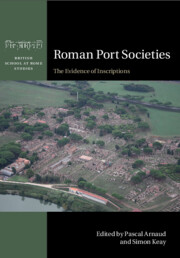Book contents
- Roman Port Societies
- British School at Rome Studies
- Roman Port Societies
- Copyright page
- Contents
- Figures
- Tables
- Contributors
- Abbreviations
- 1 The Context of Roman Mediterranean Port Societies
- 2 Inscriptions and Port Societies
- 3 Stationes and Associations of Merchants at Puteoli and Delos
- 4 Boatmen and their Corpora in the Great Ports of the Roman West (Second to Third Centuries AD)
- 5 Roman Port Societies and Their Collegia
- 6 Port Occupations and Social Hierarchies
- 7 Warehouse Societies
- 8 The Imperial Cult and the Sacred Bonds of Roman Overseas Commerce
- 9 Law and Life in Roman Harbours
- 10 Living Like a Cosmopolitan?
- 11 Ports, Trade and Supply Routes in Western Europe
- 12 The Port Society of Narona
- 13 Municipal Authority, Central Authority and Euergetists at Work at the Port
- 14 The Structure of Mercantile Communities in the Roman World
- 15 Polysemy, Epigraphic Habit and Social Legibility of Maritime Shippers
- 16 Reading Roman Port Societies
- Indexes
- References
1 - The Context of Roman Mediterranean PortSocieties
An Introduction to the PortuslimenProject
Published online by Cambridge University Press: 30 October 2020
- Roman Port Societies
- British School at Rome Studies
- Roman Port Societies
- Copyright page
- Contents
- Figures
- Tables
- Contributors
- Abbreviations
- 1 The Context of Roman Mediterranean Port Societies
- 2 Inscriptions and Port Societies
- 3 Stationes and Associations of Merchants at Puteoli and Delos
- 4 Boatmen and their Corpora in the Great Ports of the Roman West (Second to Third Centuries AD)
- 5 Roman Port Societies and Their Collegia
- 6 Port Occupations and Social Hierarchies
- 7 Warehouse Societies
- 8 The Imperial Cult and the Sacred Bonds of Roman Overseas Commerce
- 9 Law and Life in Roman Harbours
- 10 Living Like a Cosmopolitan?
- 11 Ports, Trade and Supply Routes in Western Europe
- 12 The Port Society of Narona
- 13 Municipal Authority, Central Authority and Euergetists at Work at the Port
- 14 The Structure of Mercantile Communities in the Roman World
- 15 Polysemy, Epigraphic Habit and Social Legibility of Maritime Shippers
- 16 Reading Roman Port Societies
- Indexes
- References
Summary
This is the first book to arise from aninterdisciplinary initiative, the RomanMediterranean Ports project, which seeks a holisticunderstanding of early Imperial ports by addressinga range of key questions relating to theircharacter, organization and roles.1 Thegeographical centrality of the Mediterranean to theRoman Empire, which was without precedent and hasnot been matched subsequently, helped enable itspolitical integrity for well over 400 years. By theearly first century AD, Rome had come to dominateall of the shores surrounding the Mediterranean,transforming its constituent seas into a uniquemaritime space. Interconnected commercial networkscriss-crossed its many islands and micro-regions,enabling provincial communities to maintain intensecommercial relationships with Rome at the centre ofthe mare nostrum,although debates continue to rage over their scaleand the nature of theirorganization.2
- Type
- Chapter
- Information
- Roman Port SocietiesThe Evidence of Inscriptions, pp. 1 - 35Publisher: Cambridge University PressPrint publication year: 2020



